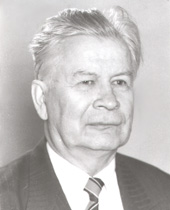Sergey Vsevolodovich Yablonsky | |
|---|---|
 Sergey Yablonsky | |
| Born | 6 December 1924 |
| Died | 26 May 1998 (aged 73) Moscow, Russia |
| Nationality | Russian |
| Alma mater | Moscow State University |
| Awards | Lenin Prize |
| Scientific career | |
| Fields | Mathematics and discrete mathematics |
| Institutions | Moscow State University Steklov Institute of Mathematics |
| Doctoral advisor | Nina Bari Pyotr Novikov |
| Doctoral students | Oleg Lupanov, Rafail Krichevskii |
Sergey Vsevolodovich Yablonsky (Russian: Серге́й Все́володович Ябло́нский, 6 December 1924 – 26 May 1998) was a Soviet and Russian mathematician, one of the founders of the Soviet school of mathematical cybernetics and discrete mathematics. He is the author of a number of classic results on synthesis, reliability, and classification of control systems (Russian: Управляющие системы), the term used in the USSR and Russia for a generalization of finite state automata, Boolean circuits and multi-valued logic circuits.
Yablonsky is credited for helping to overcome the pressure from Soviet ideologists against the term and the discipline of cybernetics and establishing what in the Soviet Union was called mathematical cybernetics as a separate field of mathematics. Yablonsky and his students were ones of the first in the world to raise the issues of potentially inherent unavoidability of the brute force search for some problems, the precursor of the P = NP problem, though Gödel's letter to von Neumann, dated 20 March 1956 and discovered in 1988, may have preceded them.[1]
In Russia, a group led by Yablonsky had the idea that combinatorial problems are hard in proportion to the amount of brute-force search required to find a solution. In particular, they noticed that for many problems they could not find a useful way to organize the space of potential solutions so as to avoid brute force search. They began to suspect that these problems had an inherently unorganized solution space, and the best method for solving them would require enumerating an exponential (in the size of the problem instance) number of potential solutions. That is, the problems seem to require "shots in the dark" (for some constant ) when the length of the problem description is . However, despite their "leading-edge" taste in mathematics, Yablonsky's group never quite formulated this idea precisely.[2]
- ^ Sipser, M. (1992), The history and status of the P versus NP question, in ‘Proceedings of the 24th Annual ACM Symposium on the Theory of Computing’, pp. 603–618.
- ^ Computational Complexity Theory (2004), Steven Rudich, Avi Wigderson, Editors, American Mathematical Society, page 12.


